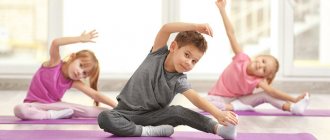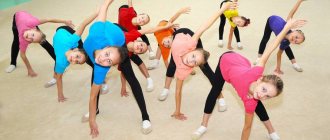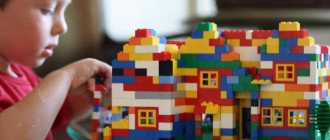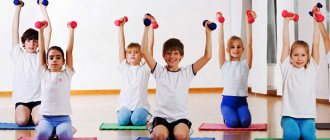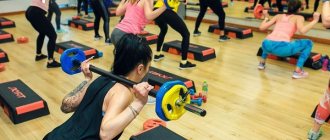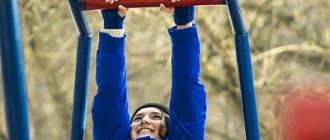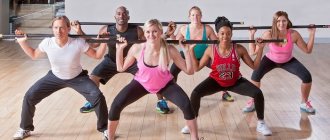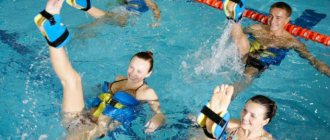Author
Evgeniy Kislitsa
experienced powerlifter and medical practitioner
Ask a Question
The article discusses the types of children's fitness, the positive aspects and disadvantages of early training.
We figure out at what age children should start training, and help them decide on the selection of sports equipment for training with children.
And, of course, we offer three of our own program options for all ages - from a one-year-old baby to a teenager.
Features of children's training
Children's training is now available in almost every sports center. The program for such classes differs significantly from the training plan for adults. Knowing the key points and features of working with the younger generation, you can avoid mistakes and inaccuracies in developing a set of exercises for children.
Training plays an important role in the development and formation of a child’s body. The activity of various body systems is directly dependent on the activity of skeletal muscles (especially important for the cardiovascular system). Especially in childhood. Physical activity stimulates metabolism, increases energy production, has a beneficial effect on the functioning of all body systems and increases its performance.
Systematic training from an early age is an excellent disease prevention. Primarily the musculoskeletal system. Namely – curvature of the spine and postural disorders. Also, children's training can prevent neuropsychic disorders (depression, fatigue, neuroses). Regular physical activity strengthens the cardiovascular system and increases the endurance of the child's body.
Be sure to check out:
Fitness for the abs at home and in the gym Fitness for beginners: competent workouts for a toned figure and healthy body Fitness at home: a sporty and toned figure Nutrition during fitness for a slim and athletic figure
The benefits of children's fitness aerobics
Aerobics is not only a set of exercises aimed at weight loss, but also a rather complex sport. It intertwines various artistic elements taken from dance, gymnastics, fitness and tap. In this case, the execution of movements is accompanied by rhythmic music, as in a dance.
When competitions are held, judges evaluate the performance according to the following parameters:
- mastery of performance
- interaction
- emotions of partners.
Athletes demonstrating their abilities in competitions must be flexible, endurance, artistic and have good coordination. They are required to demonstrate the presence of these qualities and the level of complexity of the program being performed - individually and in groups.
In order to achieve high results, you need to practice from an early age. Children's sports aerobics can begin at the age of 5–7 years.
At the same time, it is important that there are no contraindications to playing this sport and that the child has plasticity. In addition, he must have a desire to attend aerobic training.
Pros and cons of children's fitness
Children's fitness, just like other sports activities for children, has both pros and cons. This type of fitness is gaining more and more popularity due to its versatility and the ability to choose a workout based on the child’s needs.
Advantages and disadvantages
strengthening the muscle corset. During the classes, all muscle groups are worked out;
coordination of movements improves;
correct posture is formed;
improving the mobility of ligaments and joints;
since during training all muscles are involved in work, they become stronger and more resilient;
exercises normalize the functioning of the cardiovascular and respiratory systems, have a positive effect on the nervous system, and improve sleep. Children's fitness has a healing effect on the body as a whole and stimulates the immune system;
social education of the child. Group classes develop thinking, solve communication problems, and promote easy adaptation;
instilling discipline. Regular training builds self-discipline in a child. Therefore, children's fitness is recommended for children with hyperactivity or low physical activity;
possibility of injury;
mental difficulties may occur. For example, a child is very worried if he fails to complete an exercise;
lack of time on the part of parents to drop off and pick up their child from training.
As you can see, there are many more pros than cons, and if desired, even the cons can be avoided. In order not to harm your child with excessive exercise and to choose the right type of fitness, consult a pediatrician.
Dance part
According to the general education program, fitness aerobics in kindergarten, as well as dance classes, can be successfully combined, which will only bring benefits to the children. By listening to musical accompaniment and repeating certain elements, children learn to feel musical beat and rhythm, and a taste for art and aesthetics is formed and instilled in them.
Dance programs with repetitive exercises help the teacher adjust the level of load in accordance with the behavior of the children. Dancing to properly selected and liked music or a song that children like guarantees improved coordination, spatial orientation and ensures the development of plasticity.
At what age can you start training?
Most fitness clubs have developed programs for children aged 2-3 years. Some centers also conduct classes for little ones, but usually children and their parents attend them.
Children from 2 to 4 years old study with their parents, 2 times a week for 20 minutes. The exercises are aimed at developing muscles, motor skills and coordination.
For children from 4 to 6 years old, another training program has been developed, which involves aerobics, strength and functional training exercises in a playful way. This also includes elements of Logo-aerobics, when, when performing a particular exercise, children need to recite poems or tongue twisters. The duration of the workout increases to 30 minutes, you can do it 2-3 times a week.
Children from 7 to 11 years old perform exercises in classes that are aimed at strengthening muscles and developing correct posture. Exercise machines are added to the training process.
Teenagers train at a higher level of difficulty; the training duration reaches 40 minutes. During the training, the role of training on simulators increases. Especially older boys.
For boys and girls aged 12, it would be very advisable to attend classes in the pool, since swimming has a positive effect on all muscles. Plus, swimming has a beneficial effect on the condition of the spine and joints.
Sergey Sivtsov, fitness trainer
I advise parents to first decide whether they want to make their child a professional athlete or whether they perceive fitness as a way of the child’s overall development. In the first case, according to the specialist, it is advisable to send the child to big sports from an early age and not waste time on general strengthening activities. In the second case, it is very important to interest the child in the process so that the training is not only useful, but also enjoyable.
Physical development in preschool
Children's fitness is a system of activities aimed at strengthening and maintaining the health of children.
The use of fitness movements in kindergarten not only fuels interest in sports activities and teaches them to enjoy physical activity, but also improves health. Children learn to understand and control their bodies. They develop muscle strength and body plasticity, acquire correct posture and a harmonious physique.
Sports activities in kindergarten not only develop children physically, but also have a beneficial effect on their psychomotor state. Kindergarten children develop harmoniously physically, spiritually and aesthetically.
Fitness goals in kindergarten
Physical activity contributes to the development of many qualities of a child. This includes the development of motor skills, high performance, and successful mastery of new material.
Outdoor games and physical exercise have a beneficial effect on processes such as memory, attention, imagination and thinking. Sport not only develops, but also disciplines and gives self-confidence.
At the same time, physical education can help children of different temperaments:
- passive guys will be able to open up to new energies, increasing their vitality;
- hyperactive kindergarteners will learn to harmoniously distribute their energy costs;
- capricious children will be able to feel the strength of their body and become more resilient.
It is all these problems that fitness for children is designed to solve.
If we take a separate kindergarten, then the main tasks of fitness in a preschool institution are:
- Formation and improvement of children’s physical qualities (endurance, coordination, strength, agility, speed)
- Prevention of disorders in the musculoskeletal system
- Introduction to healthy lifestyle and sports
These tasks are specified based on the age group of the children.
Fitness club program for different age groups
Children's fitness involves achieving different tasks in different kindergarten groups. The main ones are listed in the table.
| For whom | Tasks |
| For the younger group |
|
| For the middle group |
|
| For older kindergarteners |
|
Important! It is recommended to devote 2-3 times a week to sports activities in kindergarten, one of which would be outside.
How to organize children's outdoor sports activities is shown in the video:
.
Types of fitness for children
There are several types of children's fitness - these are step aerobics, fitball gymnastics and children's yoga.
The peculiarity of step aerobics is to perform movements to music, where the intensity and rhythm depend on the musical accompaniment. Various sets of exercises are used here that have a positive effect on the children's body. For example, running and jumping have a positive effect on the cardiovascular system, bending and squats have a positive effect on the musculoskeletal system. Depending on the choice of exercises, step aerobics classes can be athletic, dance, psychoregulatory or mixed.
Fitball gymnastics are exercises on large elastic balls. Gymnastics of this kind helps to solve health, educational and educational problems. Also, such exercises train the ability to maintain balance. Exercises with a ball strengthen the muscles of the back and abdominals, strengthen the muscular corset of the spine, and most importantly, they form the skill of correct posture, which is very difficult and takes a long time to develop at home.
Children's yoga is especially beneficial for the physical and personal development of children. It is worth noting that children's yoga differs significantly from yoga for adults. This is due to the fact that children aged 3 to 11 years are very active and show great interest in all subjects. And, as we know, classical yoga requires concentration and calmness. Therefore, children's yoga is a little different. It uses the basics of hatha yoga, various games and fairy tales. It is from hatha yoga that the dynamic complexes and poses in ligaments that children study and perform are taken.
Gymnastics
Sport is good for health, so it is necessary to accustom the body to exercise from a very young age. Many professional athletes call gymnastics an excellent way out.
Gymnastics is a complex of acrobatic exercises and dance elements that are performed to music. In gymnastics, it is customary to distinguish three areas:
- Wellness;
- Sports;
- Applied;
Wellness or, as it is also called, developmental gymnastics is one that everyone has been familiar with since childhood. From the same school physical education lessons. The main elements of such gymnastics are jumping, somersaults, running, and exercises with a skipping rope. Health-improving gymnastics does not involve heavy loads; it is aimed at maintaining good physical shape, improving coordination of movements and acquiring new skills.
The sports direction includes all sports that are based on gymnastics as a set of special physical exercises. This:
- actual artistic gymnastics;
- gymnastics;
- sports acrobatics;
- track and field athletics;
- trampolining, etc.
To practice sports types of gymnastics, special training is required. The level of load during such training is much higher than during recreational gymnastics.
Applied gymnastics is necessary to improve certain skills. The exercises here are adapted for certain professions that require physical activity. Such complexes are used by astronauts, pilots, and firefighters.
For children who often suffer from ARVI, gymnastics will be useful, as it helps strengthen the immune system and increases the body's resistance to colds.
Fitness aerobics
Children's fitness aerobics differs from professional sports disciplines. Such activities play a healing role. Fitness aerobics does not involve excessive stress and is perfect for providing physical activity to children. Training takes place in the form of an interesting game that captivates and makes sports fun.
Such training is available for children of different ages, heights, weights, and builds. They do not require special physical training or special skills. You can start doing fitness aerobics from 1 to 1.5 years. For the youngest children, classes must be conducted in the presence and accompaniment of their parents.
One of the main advantages of children's aerobics is that in this way you can distract children from the “street” or gadgets. These classes are always interesting and more effective than other methods.
With the help of children's fitness aerobics, you can make your child's life more active. It will distract them from the TV and computer, allowing them more time to be among their peers and communicate with them. And don’t forget that children improve their health during fitness aerobics, become more resilient, strengthen their immune system, and therefore are less susceptible to illness.
Popular fitness trainer Denise Austin has developed video workouts for children that can be easily practiced at home.
Dance fitness and zumba
Dance fitness for children is a class that includes elements of choreography, rhythm, gymnastics, aerobics, and stretching. These exercises are presented in a playful way, which is why the child is always interested in them.
This type of exercise develops motor skills and coordination of movements, forms correct posture and allows you to subsequently avoid spinal diseases such as scoliosis, kyphosis, lordosis.
Dance fitness has a number of advantages compared to regular physical education:
- the lesson program is selected taking into account the child’s age, his level of mental and intellectual development and physical fitness;
- a great opportunity to throw out pent-up energy;
- there is no great physical and psychological stress;
- an individual approach to each child is provided;
- physical exercises are combined with recitative techniques, which allows you to develop a sense of rhythm and diction;
- During classes, the harmonious and comprehensive development of your child is ensured.
Zumba is a unique dance workout that combines elements of aerobics and dance. For children, this is a great option for combining benefits, fun and activity.
Zumba for children is not just a set of useless movements performed to music, but a special program developed by qualified specialists. Its goal is to develop concentration, coordination of movements, and a sense of rhythm.
The lesson program for each age group of children is individual and corresponds to their interests. Classes are conducted to rhythmic and energetic music, which is specially selected for children. The choreography of children's zumba is very simple: it cleverly combines aerobics with various Latin American and modern dance movements. Also, dances often use elements of hip-hop.
Acrobatics
Acrobatics is a very ancient discipline. Acrobatics, like gymnastics, fully develops agility, balance, flexibility and strength. After all, these qualities are necessary for constructing complex elements and their combinations.
Previously, only circus performers who performed dangerous stunts at height were called acrobats. Today the sport is divided into separate areas:
- sports acrobatics, it can be jumping, pairs and group;
- circus acrobatics - represents spectacular elements and tricks performed in the circus;
- special acrobatics - is part of dance, used in martial arts, as well as for training combat units.
Acrobatics classes will tame a restless child, because performing the exercises requires not only physical strength, but also a high concentration of attention. Thus, both the child’s body and nervous system get tired.
Acrobatic clubs are quite suitable for schoolchildren. After all, at this age it is difficult for them to do without movement, and exercise will become a breath of clean air for them.
Little acrobats will be able to quickly react to dangerous situations, maintain balance and not fall, and group correctly if a fall cannot be avoided. They will perform tasks on speed, agility and endurance with ease.
Sports acrobatics can be practiced by both boys and girls. The only difference is that three girls compete in group disciplines, and four boys compete in group disciplines.
The question logically arises: “At what age do you start taking acrobatics?” Children from 4 years old are accepted for acrobatics classes.
Gymnastics
Rhythmic gymnastics is a popular, beautiful and graceful sport for girls. The grace of this sport is simply mesmerizing. Rhythmic gymnastics has a number of advantages:
- Strengthens health. Regular gymnastics makes muscles stronger, improves immunity, and improves metabolism. The benefit of rhythmic gymnastics for children also lies in the treatment of the initial stage of scoliosis. Regular stretching makes the spine stronger and straightens it.
- Improves physical fitness. Frequent exercise over a long period of time has a positive effect on the child’s body. Exercises help develop correct posture and gait and strengthen muscles. Girls learn to control their bodies, become more flexible and flexible.
- Builds character. High demands from the coach increase stress resistance and teach perseverance. Athletes are less prone to depression, especially if playing sports is a hobby and brings pleasure.
When talking about any sport, you cannot only touch on its positive aspects.
Rhythmic gymnastics is no exception, and has its disadvantages:
- Working out can be painful . In rhythmic gymnastics, much attention is paid to stretching, which children do not really like. Doing the splits is not very pleasant at first, but over time all pain goes away;
- Exercise makes you tired . Frequent long-term training greatly exhausts children;
- Missing school due to competitions . As a result, children are forced to study the school curriculum on their own.
It is recommended to send children to rhythmic gymnastics at the age of 5-6 years.
Fitness on trampolines
Fitness on trampolines, or as it is also called “Jumping Fitness”, is a specially developed specific training program.
Trampoline activities are allowed even for children over 3 years old. But still, not all children will be able to attend such classes. Fitness on trampolines is prohibited for children who have:
- problems with the musculoskeletal system;
- diseases of the cardiovascular system;
- pathologies of the respiratory system.
This type of fitness does not require special equipment. For exercise, regular sportswear is sufficient.
These are the workouts:
- develop coordination of movements in children;
- optimize motor activity;
- direct the child’s energy in the right direction.
Fitness on trampolines combines jumps of varying duration, various options for aerobic steps, fast and dynamic sports elements.
Jumping, which is an integral part of trampoline fitness, will help relieve stress and tension for your child. Trampolines give children a feeling of joy, happiness and lightness.
Yulia Agafonova, children's fitness trainer
It is important to screen your baby for diseases before starting fitness classes. In some cases, minor deviations that seem harmless to parents can cause the child to be injured during exercise.
Why fitness is for children
Children really need fitness for several reasons:
- No need to win. Everyone is treated equally and rewarded equally. Winning is not valued as much as participation.
- Game form of classes. The training program is structured in such a way that children want to return to the walls of the fitness club, do the exercises and get exceptional pleasure from it.
- The ability to choose. The character of each child is individual. Some people won't like dancing, others won't like repetition exercises. Therefore, sports institutions give the child the opportunity to choose the direction and type of activities that will make up his program, after first allowing him to familiarize himself with each of the options.
- Safety. The likelihood of injury during training is reduced to zero. The instructor constantly monitors the children, and the exercises are selected especially carefully.
- Availability. The doors of a fitness club or dance school, which also conduct children's fitness classes, are open to all children over 3 years old. And the level of physical fitness does not play a role here, since fitness is designed to strengthen the kids.
What to do with
Being active means being healthy. It is not necessary to engage in fitness professionally and achieve high results. To stay in shape, simply exercise regularly and expose yourself to moderate physical activity. Aerobics and fitness are disciplines that are aimed at keeping fit. But in addition to exercise, they require adherence to a daily routine, healthy eating, and proper rest.
For the classes to be truly beneficial, your child will need the right equipment. It includes many products such as fitball, jump rope, mat, hoop. Having which the child will be able to fully train at home.
From the age of 8, work with sports equipment begins: a ball, a jump rope, a hoop. Various team games can be arranged for children.
Fitness ball
A fitball is a special large rubber fitness ball that has many advantages:
- lightweight - can easily be rolled or moved to another place;
- durable – can withstand weight up to 180 kg;
- does not explode, thanks to a special anti-explosion system;
- multifunctional – allows you to perform various exercises;
- develops coordination of movements;
- has no age restrictions - suitable for infants, pensioners, children and adults;
Fitness balls come in different sizes depending on the height and weight of the child. To understand whether the fitball is chosen correctly you need to:
- sit on the ball;
- position your legs so that your feet fit snugly to the floor;
- make sure that your knees are bent at right angles;
If all points match, then the size is chosen correctly.
You can also choose the color of the ball, its surface (smooth or textured). In addition, fitballs come with or without handles.
Rug
A gymnastic mat is an indispensable item for aerobics and fitness classes for your children. Of course, sports clubs can offer their mats for temporary use, but it is better to have your own. After all, you can work with it anywhere.
To choose the right rug size, simply add 10 cm to the child’s height. The width and thickness of the rug also vary. You need to choose them based on your feeling of comfort.
Important! The thinner the thickness, the colder and harder it will lie on the mat.
Today, training mats are available in a wide variety of bright colors. Your child will be happy to take such convenient, practical and lightweight equipment to class.
Step
A step platform is a specially designed platform for fitness and step aerobics that simulates climbing and descending stairs.
Due to the fast pace of life, there is not always time to go to the gym, so the option of home workouts remains. Sports equipment is ideal for this purpose. One of them is a step platform, which is very practical and effective.
Now it is used in step aerobics, for cardio training and as an auxiliary equipment for performing various exercises.
Externally, the step platform resembles a rectangular bench with adjustable height. When choosing a step platform, pay attention to the following:
- material – the working surface should not slip;
- platform dimensions - depends on the size of the foot;
- height adjustment;
- stability – step platforms must be equipped with rubber “feet” to prevent slipping on the floor;
The step platform is used in classes with children such as:
- morning exercises;
- aerobics (10-15 minutes of platform exercises);
- during training preparation for sports holidays;
- during training for children of senior preschool age (25-30 minutes of training on a step platform).
All of the above activities will lead to overall strengthening of the body and normalization of metabolic processes.
Jump rope and hoop
Another sports attribute is a jump rope. Thanks to the jump rope, you can train different muscle groups at the same time. In addition, the jump rope also allows you to develop coordination of movements, endurance, train the cardiovascular system and significantly increase lung capacity.
A jump rope is a simple but very effective sports equipment for training, both in the gym and at home.
Benefits of classes
The main positive features of fitness for children include:
- Training does not last long and does not overload the child;
- Aerobics for children involves group (including play) forms of work - accordingly, in addition to physical development, this makes it possible to develop a number of necessary communication skills in children;
- The instructor always practices an individual approach to each student;
- Gymnastics for children is the best choice if the child does not attend preschool and, against this background, experiences a lack of communication and physical activity;
- During training, children develop many useful skills - in particular, flexibility, mobility, coordination, ability to behave in a team, agility, strength, etc.
Any fitness classes will certainly help normalize the child’s body weight; in addition, physical exercise is an excellent prevention of diseases of the cardiovascular system, scoliosis, and damage to the knee joints.
The main advantage of children's fitness is a wide range of activities and, accordingly, the presence of a main motive to engage in: the child's interest in this form of pastime.
Programs by age
Children often have a lack of movement due to spending a long time watching TV and gadgets. All this leads to decreased immunity, slower metabolism, poor health, poor posture, and increases the likelihood of childhood obesity.
Therefore, sports should begin from a very early age, since the physical and intellectual development of a child is closely related. Fitness classes not only have a positive effect on health and form correct posture, but also contribute to the development of logical thinking and imagination of the child.
You need to know that children's fitness is primarily aimed at healing and strengthening the body. To ensure that this type of exercise does not cause harm, the training program must be selected in accordance with the age of the child.
Properly selected physical activity is good for health. After all, they:
- strengthen the musculoskeletal system and especially the muscles;
- have a beneficial effect on the functioning of the cardiovascular, immune and nervous systems;
- help you get rid of problems with sleep and bad mood.
Yuri Fedorov, fitness trainer
Regardless of the age of the athlete, his training must include cardio. Thus, the heart muscle is strengthened and the body becomes more resilient. You don’t need to devote a lot of time to cardio training; 10 minutes at the beginning of the complex will be enough.
The choice of specific directions directly depends on the age, individual preferences and physical fitness of the child.
With a child under one year old at home
You can work with a child up to one year from the age of six months. You can start with activities such as:
- swimming;
- stretching exercises;
- games aimed at developing fine motor skills.
Also, with the help of massage and a special set of exercises, classes will help strengthen the baby’s muscles. Exercises are performed together with parents. The activity should be based on play. Trainings may have a fairy-tale plot and game moments of imitation of animals or fairy-tale characters. If toys are part of the plot, then they need to be used and introduced into the training scenario. However, you need to understand that a favorite toy can distract your baby from training.
As a rule, at this age it is difficult for a child to focus attention for a long time, so classes last no more than 15 minutes.
After the baby begins to walk, it is necessary to include exercises in the program to form a beautiful and correct gait in the child. At this age, all activities and exercises are aimed at developing the child’s fine motor skills, mastering balance skills, forming the correct arch of the foot and preventing the development of flat feet.
For children 3-6 years old
Children from 3 years old can already start doing children's fitness, but classes should last no more than 20-30 minutes and take place twice a week. From the age of 5 you can exercise 3 times a week for 30 minutes.
At this age, the child is fully aware of himself and feels the boundaries of his self. Training can be not only playful, but also a little competitive. But for the most part, training is still a game at this stage. However, already at that time it is necessary to formulate in the child the idea that he is engaged in an important activity or an interesting sport. It is very important to communicate with children during classes, as well as monitor their progress. Be sure to praise the child.
Children from 3 to 6 years old develop excellent physical quality such as flexibility. This is important to consider during training.
It is important to remember that the coordination abilities of children at this age are not yet developed, so during training, frequent falls are possible (depending on the sport), which can lead to minor abrasions, abrasions and bruises.
For schoolchildren and teenagers
Schoolchildren aged 8 to 10 regularly play sports in physical education classes. Training with elements of sports disciplines is what they need at this age. Some of them begin not only to become interested in sports, but also acquire sports idols. Especially if children are raised in a sports family, then, as a rule, they are already focused on a certain direction in sports.
It is important that the child already at this age begins to feel personal responsibility for preparing for training:
- checked the styling of sports uniforms;
- or he packed it and the sports equipment himself.
At this age, schoolchildren begin to be burdened with studies, and lessons take up a lot of their time. Therefore, it is simply necessary to let the child throw out energy.
The duration of the workout increases from 45 to 60 minutes.
If a child develops a strong interest in any sport, that’s great. Support him!
However, if the child did not like it at the first training session, this does not mean that this sport should be abandoned. Perhaps the child just hasn’t gotten the hang of it yet.
Schoolchildren aged 10 to 13 years old form their attitude towards sports and their health at this age. They begin to actively develop their speed and strength qualities, which corresponds to the physiology of this age. Therefore, you can safely increase the duration of the workout to 90 minutes. However, this must necessarily happen gradually.
Teenagers aged 14 years and older are already fully self-determined. Some children at this age, in pursuit of external attractiveness, rush to the gym. This is due to the fact that from the age of 14 an active increase in muscle mass begins, flexibility and strength endurance develop especially quickly.
Teenagers play sports for 60 to 90 minutes. The training always includes a warm-up and a final part – a cool-down.
How the training goes
Children's fitness for kids involves active exercises in a playful way. Thus, children dance and perform simple physical exercises to specially selected songs from cartoons or classical music.
Modern fitness centers offer many options for children's training. Here are the most popular ones:
- Logo aerobics . The essence of this direction is the combination of physical exercises with the recitation of poems and unrhymed phrases. The main goal of the classes is to develop coordination.
- Step by step . At such trainings, instructors teach children to walk correctly, develop the ability to maintain body balance, and develop fine motor skills.
- Fit Ball . Active physical exercises using large inflatable balls. Classes help develop the child’s musculoskeletal system.
- Yoga for children . Training has a positive effect not only on physical development, but also on the emotional sphere of children.
- Children's training in the pool . Swimming with elements of aqua aerobics. An excellent choice for hyperactive guys.
Main conclusions
- Regular fitness classes will have a positive effect on your child's health and appearance.
- Understanding the peculiarities of children's training, parents will be able not only to competently create a set of exercises for their baby, but also to protect him from the negative impact of classes on the condition of the growing body.
- Careful study by parents of the technique of performing exercises for children will help to significantly increase the effectiveness of this type of training.
- With the wrong approach to training and the wrong load and set of exercises, training can harm the child’s health.
- Before sending a child to one or another section, it is recommended that he be consulted and examined by a pediatrician for any contraindications to sports.
Sources used when writing this article
https://sportwiki.to Age, children for admission to different sports https://cyberleninka.ru/article/n/osobennosti-fizicheskogo-razvitiya-detey-kotorye-zanimayutsya-raznymi-vidami-sporta https://www .activekids.com/parenting-and-family/articles/10-rules-to-keep-kids-active https://www2.ed.gov/free/features/physical-fitness-and-sports.html https:/ /www.safesport.co.uk/what-are-rules-children-gym-equipment.html
